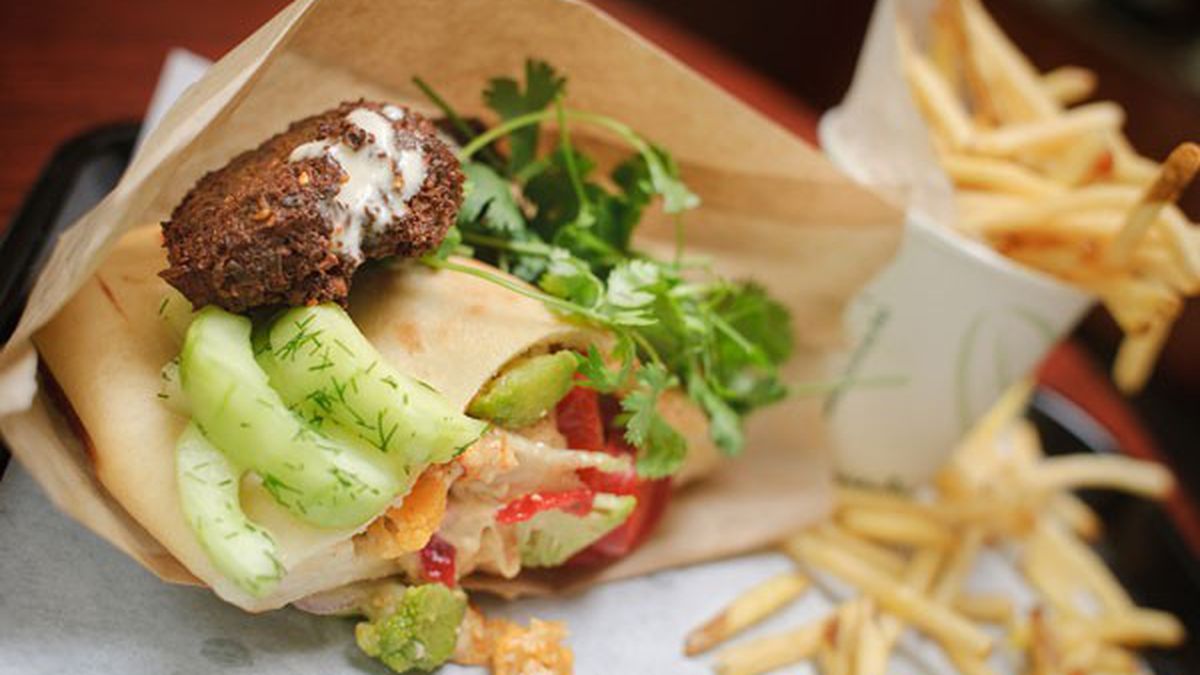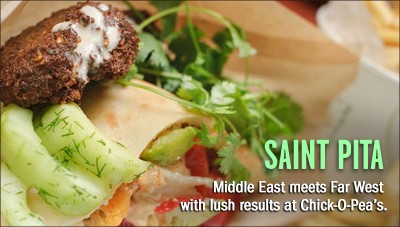They call falafel street food. And fast food. The first time I ever heard its name, at a festival attended on a high-school field trip, a teacher told me, “It’s an Israeli hot dog.” And yes, you get them fast and eat them fast at stands around the world. But say — just say — you got one that you wouldn’t want to wolf while striding down the street, because you owe it more than that, because each bite bursts juicy-chewy-crunchy-hot, then yields a sneaky slow sophisticated spice charge on the double-take. Say both halves of your brain insist that this be eaten sitting down because it tastes not mass-produced but crafted, like the fancy salads at those places you can’t afford up the street. Say this falafel overflows almost deliberately, the way some folks drop keys or shriek with laughter when they flirt, and it would not just irk but sadden you to miss a bite. Then it’s not street food anymore, is it? Lines have been crossed. It’s something else, the sort of hybrid that could be conceived only in Berkeley: sit-down street food.
But of course.
Luckily, at Chick-O-Pea’s, you can sit down — at outdoor tables flanking this month-old purveyor of those lush tahini-gushers or at tiny tables inside. They’re part of a sleek look carried out in clean lines and Sahara-hot siennas by Santa Cruz designer Eric Schmidt, whom Chick-O-Pea’s owner Kamran Nassiri hired to transform this narrow space on the Gourmet Ghetto’s farthest fringe from the bakery it used to be.
Schmidt “did my wife’s dental office,” Nassiri says. “I said, ‘Eric, you’ve got to come up and do my restaurant.'” The first eatery Schmidt ever designed, it conveys that whole hybrid mien: cool asymmetrical-curves metropolitan but, with its tuber hues and touches such as an urn of mint-and-cucumber-infused drinking water, whispering: souk.
The idea for this place came about in Paris, where on a wedding-anniversary trip Nassiri and his wife watched lines of eager customers winding out of popular falafel spots into the streets of the Latin Quarter. Those lines moved swiftly. But they never shortened, because more and more customers kept arriving. A Bay Area restaurant-business veteran who recently became a strict vegetarian, Nassiri envisioned a Berkeley version of what he saw in Paris. But the difference between his and the standard falafel shop was that his would be entirely meatless: not a gyro in sight. He would add vegan dishes as well, use mainly organic ingredients, and make all his serving-ware and bags biodegradable.
Also setting Chick-O-Pea’s apart is its falafel/salad bar, where a periodically shifting array of nine or more exotic toppings can be ladled or pincered at will into falafels and atop romaine or organic baby greens. Exuding sunshiny perfumes that mingle citrus with sumac, cilantro, and midday in an alcázar’s garden, this indulgence is worth a journey from afar. Salads here are priced not by the ounce but by the plate, so pile it on.
House made and based on traditional recipes — mainly Lebanese, as Iranian-born Nassiri favors those flavors — the toppings range from slivered almonds and dried cranberries to black-eyed-pea relish, dilled cucumber, herbed cauliflower, hummus, jicama, tomato salsa, peppery crinkle-cut carrots, scorching-hot harissa, sweet roasted beets, pickled red onions, pickled celeriac, taratour tahini sauce, a Levantine coleslaw, and mixed beans made elegant with garlic and gourmet-grade olive oil. An unprepossessing squeeze bottle bears zhoug, Yemen’s cumin-spiked answer to green salsa. Hot beyond hot, it outburns even the North African harissa, whose scarlet sear-power appears not only at the salad bar but also as one of five flavors with which french fries can be tossed here, along with pesto, saffron-aioli, “Sahara Dust” (garlic/hot pepper/sesame seeds), and — surprise! — jerk.
All the fries are shoestring. This, Nassiri says, is because their small size holds flavors better. The serving is generous: three fistfuls of fries, fresh from their boiling, cholesterol-free rice-oil bath, each coffee-stirrer-width and stiff and crisp. If you like small firm fries, fine. I don’t, because to be honest with you I like a heavy soggy fry, the sort that dangles. Please do not interpret that. Don’t even try.
Nor do I savor hot flavors as much as mild and sweet ones, so another problem for my kind is that three of the five french-fry flavors are hot. The starch battles the fire, a back-and-forth barrage that makes mouth membranes buzz.
Creamy respite awaits in cacik, a mint-crowned cucumber-yogurt dip sold by the plate as are hummus, wetter-than-most tabouleh, and silky, fruity, filling if not-quite-intense baba ghanoush. Fans of the not-hot will also like the stew-thick chickpea-noodle soup.
All of this is background music for the falafel, its crunchy-outside, spunky-inside, Mystic Mint-sized chickpea patties packed with onion, tomato, cucumber, and salad-bar stuffed into a startlingly thick crescent of pale golden, pillowy-soft-but-pliable pita that is nothing like those thin flaps sold in supermarkets. It’s baked on site and based on a recipe by Peter Reinhart, the James Beard Award-winning author of The Bread Baker’s Apprentice. That’s a Western touch, as is the agave nectar that replaces honey in a light, spicy, pistachio-studded baklava. As, too, are pita fries: Gleaming almost bronze, these long thick strips of leftover bread are a ravishingly oily foil for cacik and the other dips. This is the world’s savviest salvaging trick. Paris can wait.














